Financial Report: Alpen Choc Project - Break-Even & Cash Flow Analysis
VerifiedAdded on 2023/01/12
|24
|7207
|1
Report
AI Summary
This report presents a comprehensive financial analysis of the Alpen Choc project, evaluating two potential business ventures for Isaac, a Canadian entrepreneur. The analysis includes break-even analysis for both projects, detailing the point at which each becomes profitable, and comparing the potential financial returns of selling chocolates online versus selling to a friend. The report also provides a detailed profit and loss statement and balance sheet for Project 1, offering insights into the project's financial performance and position. Furthermore, the report examines monthly and annual cash flow projections, crucial for understanding the project's liquidity and long-term financial viability. Risk factors are assessed, and a final recommendation is made, considering both financial projections and the entrepreneur's risk appetite. The report uses assumptions to address incomplete information and considers currency exchange rates, cost structures, and sales strategies to provide a well-rounded financial assessment. The report concludes with a recommendation for Isaac, considering both the financial projections and risk factors associated with each project.
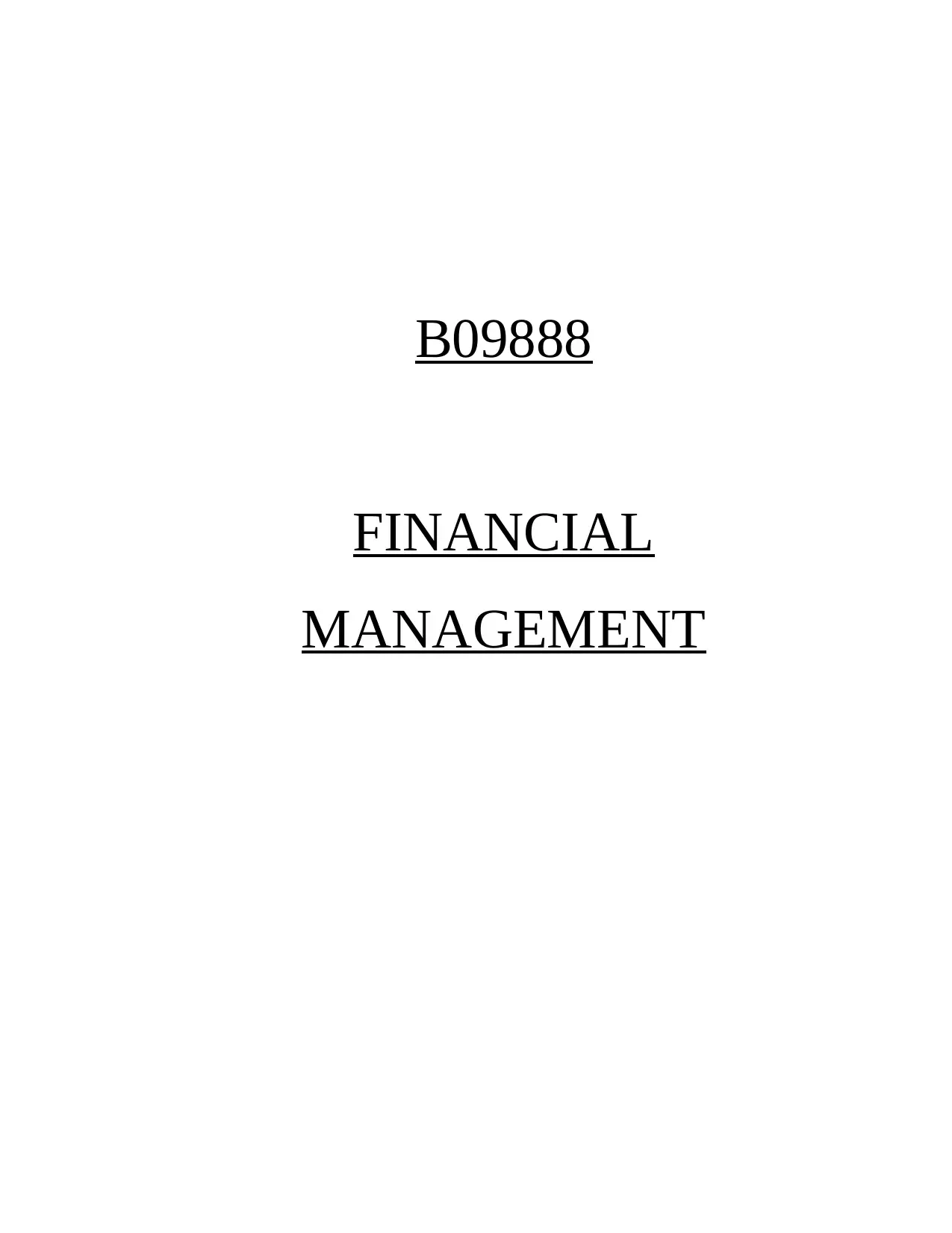
B09888
FINANCIAL
MANAGEMENT
FINANCIAL
MANAGEMENT
Paraphrase This Document
Need a fresh take? Get an instant paraphrase of this document with our AI Paraphraser
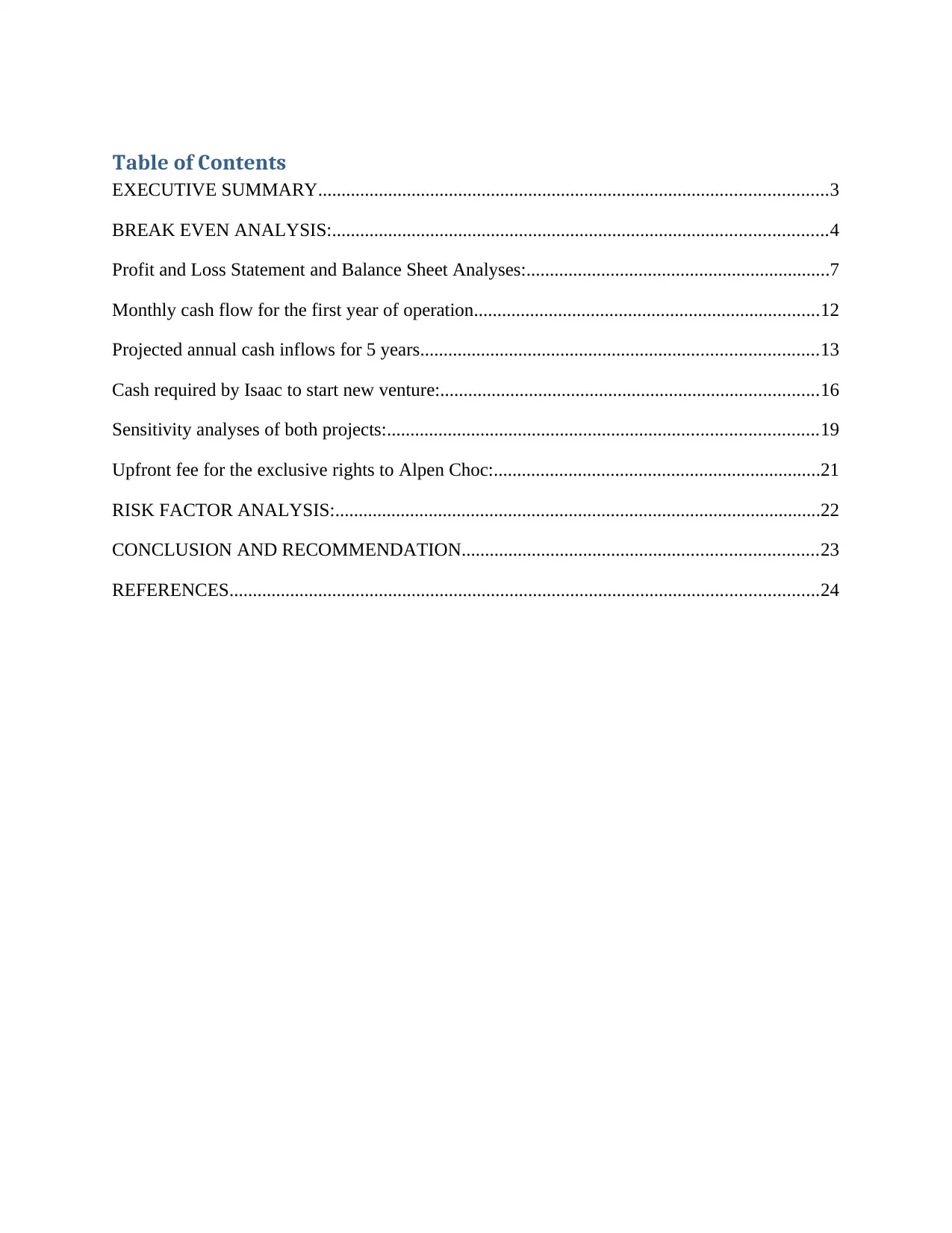
Table of Contents
EXECUTIVE SUMMARY.............................................................................................................3
BREAK EVEN ANALYSIS:..........................................................................................................4
Profit and Loss Statement and Balance Sheet Analyses:.................................................................7
Monthly cash flow for the first year of operation..........................................................................12
Projected annual cash inflows for 5 years.....................................................................................13
Cash required by Isaac to start new venture:.................................................................................16
Sensitivity analyses of both projects:............................................................................................19
Upfront fee for the exclusive rights to Alpen Choc:......................................................................21
RISK FACTOR ANALYSIS:........................................................................................................22
CONCLUSION AND RECOMMENDATION............................................................................23
REFERENCES..............................................................................................................................24
EXECUTIVE SUMMARY.............................................................................................................3
BREAK EVEN ANALYSIS:..........................................................................................................4
Profit and Loss Statement and Balance Sheet Analyses:.................................................................7
Monthly cash flow for the first year of operation..........................................................................12
Projected annual cash inflows for 5 years.....................................................................................13
Cash required by Isaac to start new venture:.................................................................................16
Sensitivity analyses of both projects:............................................................................................19
Upfront fee for the exclusive rights to Alpen Choc:......................................................................21
RISK FACTOR ANALYSIS:........................................................................................................22
CONCLUSION AND RECOMMENDATION............................................................................23
REFERENCES..............................................................................................................................24
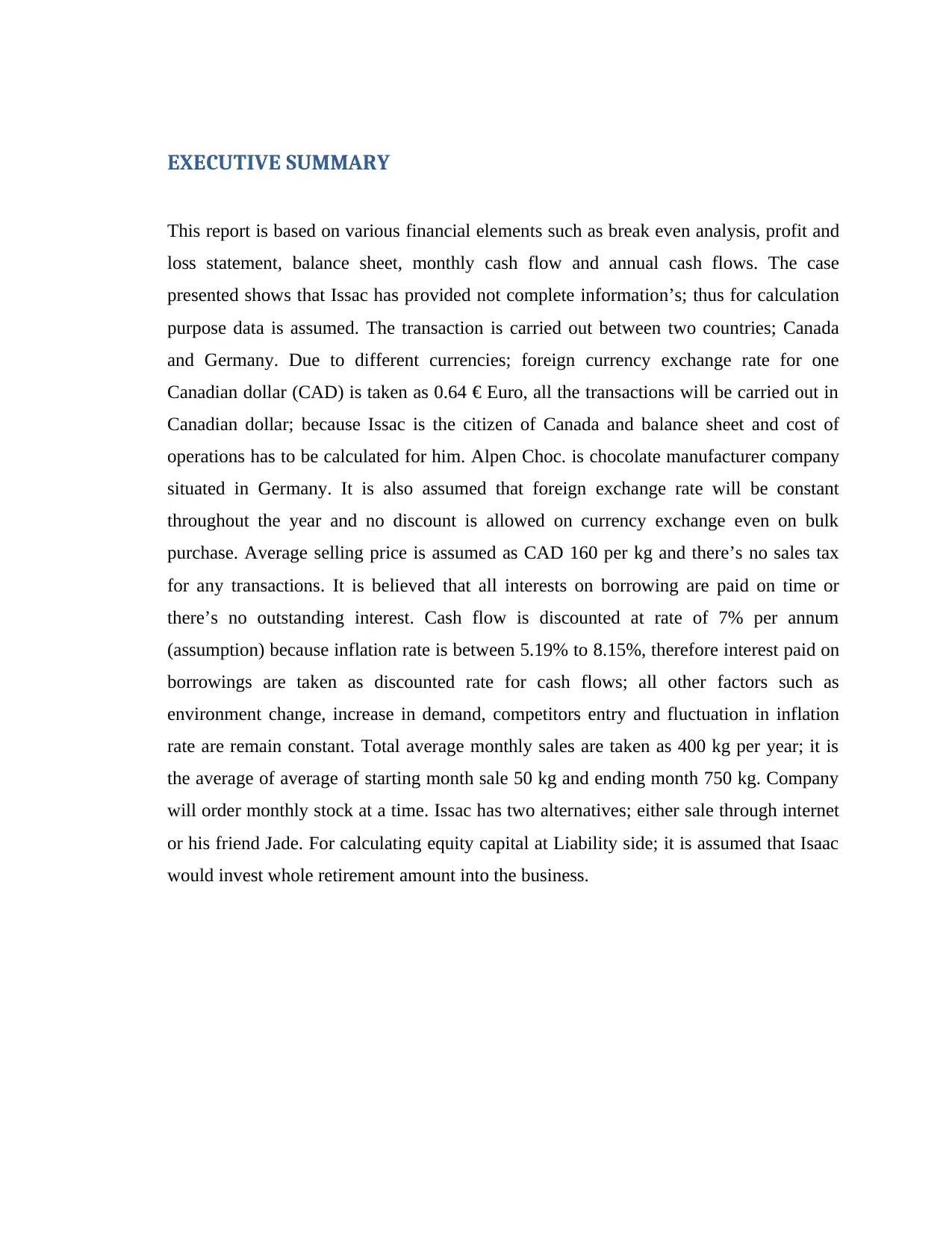
EXECUTIVE SUMMARY
This report is based on various financial elements such as break even analysis, profit and
loss statement, balance sheet, monthly cash flow and annual cash flows. The case
presented shows that Issac has provided not complete information’s; thus for calculation
purpose data is assumed. The transaction is carried out between two countries; Canada
and Germany. Due to different currencies; foreign currency exchange rate for one
Canadian dollar (CAD) is taken as 0.64 € Euro, all the transactions will be carried out in
Canadian dollar; because Issac is the citizen of Canada and balance sheet and cost of
operations has to be calculated for him. Alpen Choc. is chocolate manufacturer company
situated in Germany. It is also assumed that foreign exchange rate will be constant
throughout the year and no discount is allowed on currency exchange even on bulk
purchase. Average selling price is assumed as CAD 160 per kg and there’s no sales tax
for any transactions. It is believed that all interests on borrowing are paid on time or
there’s no outstanding interest. Cash flow is discounted at rate of 7% per annum
(assumption) because inflation rate is between 5.19% to 8.15%, therefore interest paid on
borrowings are taken as discounted rate for cash flows; all other factors such as
environment change, increase in demand, competitors entry and fluctuation in inflation
rate are remain constant. Total average monthly sales are taken as 400 kg per year; it is
the average of average of starting month sale 50 kg and ending month 750 kg. Company
will order monthly stock at a time. Issac has two alternatives; either sale through internet
or his friend Jade. For calculating equity capital at Liability side; it is assumed that Isaac
would invest whole retirement amount into the business.
This report is based on various financial elements such as break even analysis, profit and
loss statement, balance sheet, monthly cash flow and annual cash flows. The case
presented shows that Issac has provided not complete information’s; thus for calculation
purpose data is assumed. The transaction is carried out between two countries; Canada
and Germany. Due to different currencies; foreign currency exchange rate for one
Canadian dollar (CAD) is taken as 0.64 € Euro, all the transactions will be carried out in
Canadian dollar; because Issac is the citizen of Canada and balance sheet and cost of
operations has to be calculated for him. Alpen Choc. is chocolate manufacturer company
situated in Germany. It is also assumed that foreign exchange rate will be constant
throughout the year and no discount is allowed on currency exchange even on bulk
purchase. Average selling price is assumed as CAD 160 per kg and there’s no sales tax
for any transactions. It is believed that all interests on borrowing are paid on time or
there’s no outstanding interest. Cash flow is discounted at rate of 7% per annum
(assumption) because inflation rate is between 5.19% to 8.15%, therefore interest paid on
borrowings are taken as discounted rate for cash flows; all other factors such as
environment change, increase in demand, competitors entry and fluctuation in inflation
rate are remain constant. Total average monthly sales are taken as 400 kg per year; it is
the average of average of starting month sale 50 kg and ending month 750 kg. Company
will order monthly stock at a time. Issac has two alternatives; either sale through internet
or his friend Jade. For calculating equity capital at Liability side; it is assumed that Isaac
would invest whole retirement amount into the business.
⊘ This is a preview!⊘
Do you want full access?
Subscribe today to unlock all pages.

Trusted by 1+ million students worldwide
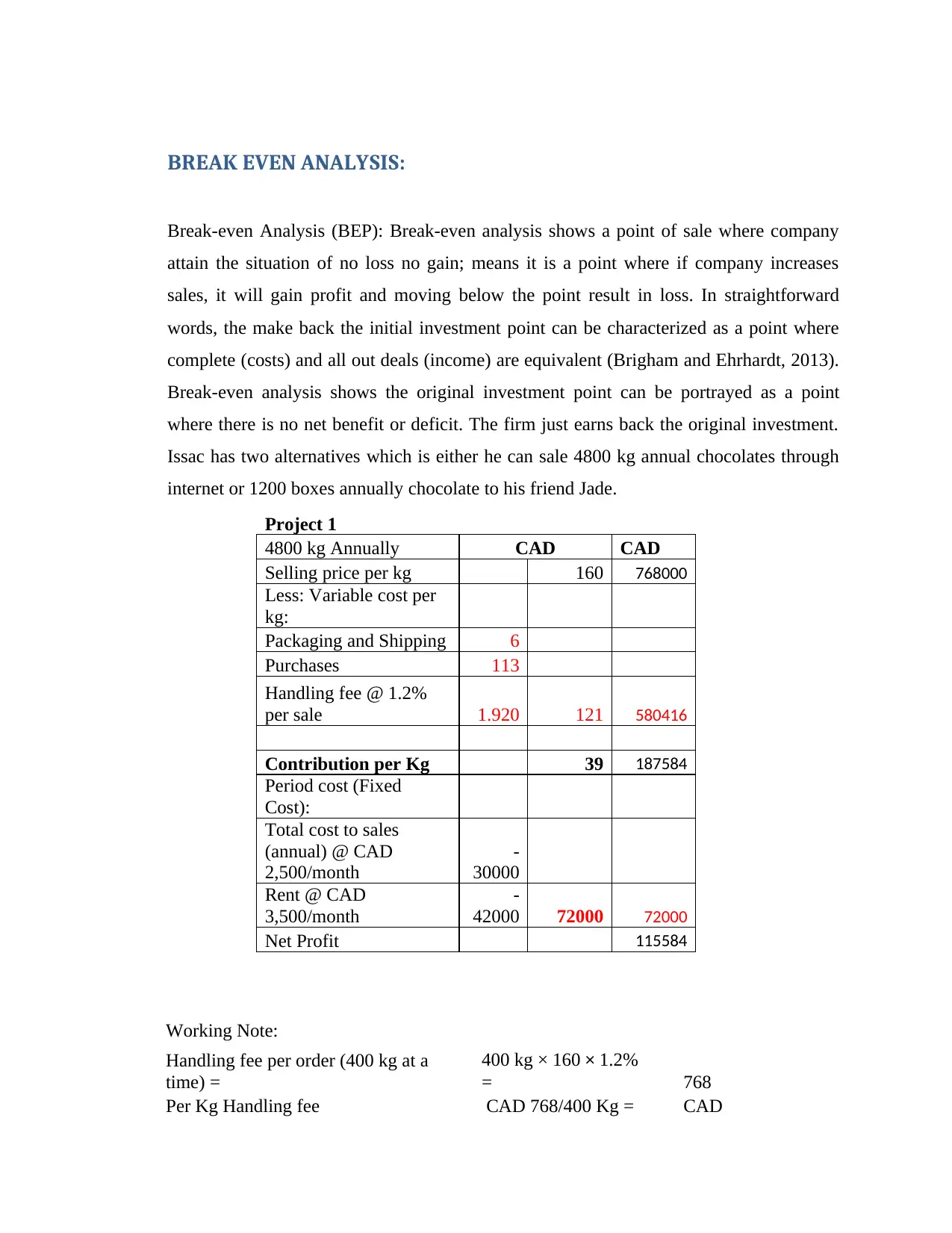
BREAK EVEN ANALYSIS:
Break-even Analysis (BEP): Break-even analysis shows a point of sale where company
attain the situation of no loss no gain; means it is a point where if company increases
sales, it will gain profit and moving below the point result in loss. In straightforward
words, the make back the initial investment point can be characterized as a point where
complete (costs) and all out deals (income) are equivalent (Brigham and Ehrhardt, 2013).
Break-even analysis shows the original investment point can be portrayed as a point
where there is no net benefit or deficit. The firm just earns back the original investment.
Issac has two alternatives which is either he can sale 4800 kg annual chocolates through
internet or 1200 boxes annually chocolate to his friend Jade.
Project 1
4800 kg Annually CAD CAD
Selling price per kg 160 768000
Less: Variable cost per
kg:
Packaging and Shipping 6
Purchases 113
Handling fee @ 1.2%
per sale 1.920 121 580416
Contribution per Kg 39 187584
Period cost (Fixed
Cost):
Total cost to sales
(annual) @ CAD
2,500/month
-
30000
Rent @ CAD
3,500/month
-
42000 72000 72000
Net Profit 115584
Working Note:
Handling fee per order (400 kg at a
time) =
400 kg × 160 × 1.2%
= 768
Per Kg Handling fee CAD 768/400 Kg = CAD
Break-even Analysis (BEP): Break-even analysis shows a point of sale where company
attain the situation of no loss no gain; means it is a point where if company increases
sales, it will gain profit and moving below the point result in loss. In straightforward
words, the make back the initial investment point can be characterized as a point where
complete (costs) and all out deals (income) are equivalent (Brigham and Ehrhardt, 2013).
Break-even analysis shows the original investment point can be portrayed as a point
where there is no net benefit or deficit. The firm just earns back the original investment.
Issac has two alternatives which is either he can sale 4800 kg annual chocolates through
internet or 1200 boxes annually chocolate to his friend Jade.
Project 1
4800 kg Annually CAD CAD
Selling price per kg 160 768000
Less: Variable cost per
kg:
Packaging and Shipping 6
Purchases 113
Handling fee @ 1.2%
per sale 1.920 121 580416
Contribution per Kg 39 187584
Period cost (Fixed
Cost):
Total cost to sales
(annual) @ CAD
2,500/month
-
30000
Rent @ CAD
3,500/month
-
42000 72000 72000
Net Profit 115584
Working Note:
Handling fee per order (400 kg at a
time) =
400 kg × 160 × 1.2%
= 768
Per Kg Handling fee CAD 768/400 Kg = CAD
Paraphrase This Document
Need a fresh take? Get an instant paraphrase of this document with our AI Paraphraser
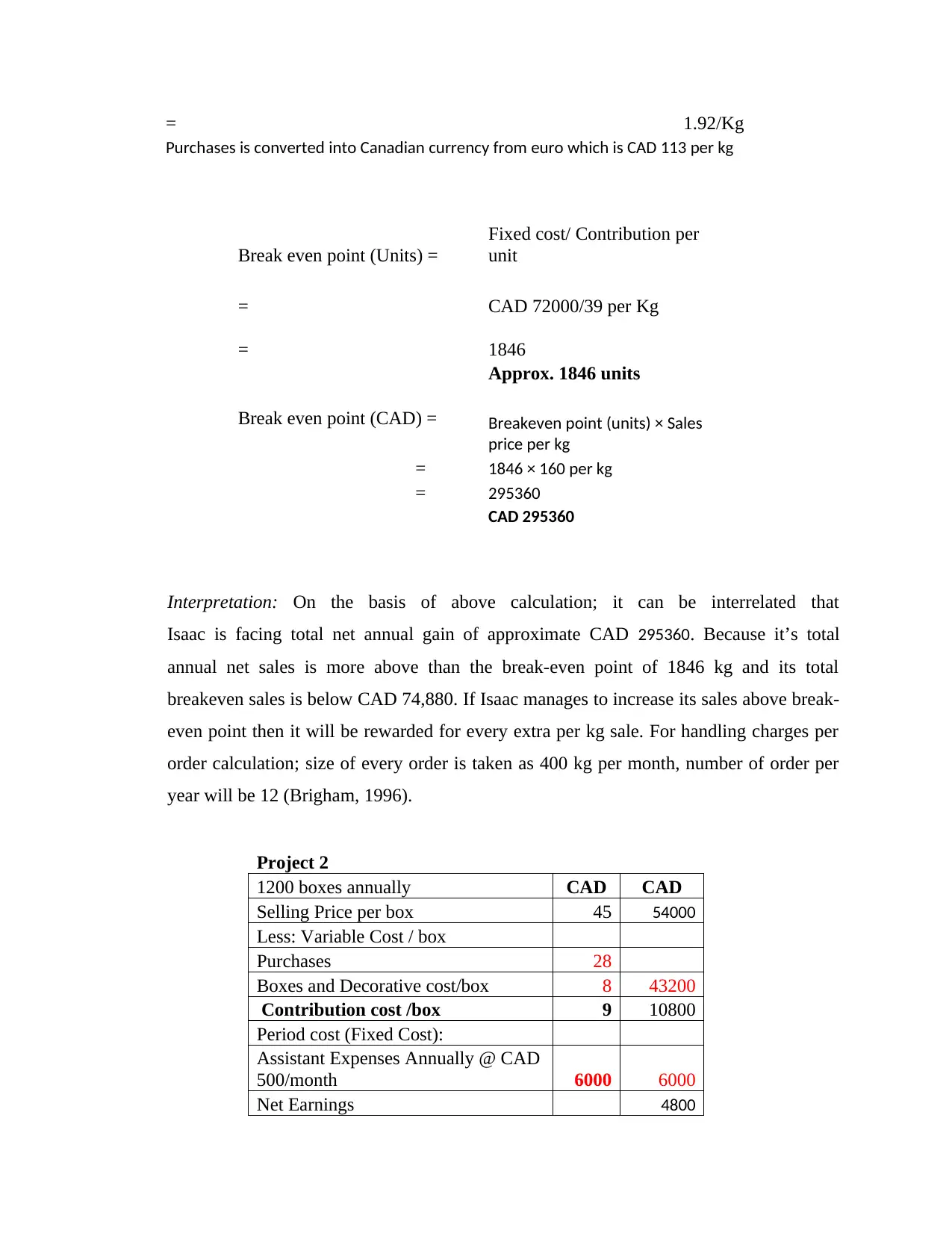
= 1.92/Kg
Purchases is converted into Canadian currency from euro which is CAD 113 per kg
Break even point (Units) =
Fixed cost/ Contribution per
unit
= CAD 72000/39 per Kg
= 1846
Approx. 1846 units
Break even point (CAD) = Breakeven point (units) × Sales
price per kg
= 1846 × 160 per kg
= 295360
CAD 295360
Interpretation: On the basis of above calculation; it can be interrelated that
Isaac is facing total net annual gain of approximate CAD 295360. Because it’s total
annual net sales is more above than the break-even point of 1846 kg and its total
breakeven sales is below CAD 74,880. If Isaac manages to increase its sales above break-
even point then it will be rewarded for every extra per kg sale. For handling charges per
order calculation; size of every order is taken as 400 kg per month, number of order per
year will be 12 (Brigham, 1996).
Project 2
1200 boxes annually CAD CAD
Selling Price per box 45 54000
Less: Variable Cost / box
Purchases 28
Boxes and Decorative cost/box 8 43200
Contribution cost /box 9 10800
Period cost (Fixed Cost):
Assistant Expenses Annually @ CAD
500/month 6000 6000
Net Earnings 4800
Purchases is converted into Canadian currency from euro which is CAD 113 per kg
Break even point (Units) =
Fixed cost/ Contribution per
unit
= CAD 72000/39 per Kg
= 1846
Approx. 1846 units
Break even point (CAD) = Breakeven point (units) × Sales
price per kg
= 1846 × 160 per kg
= 295360
CAD 295360
Interpretation: On the basis of above calculation; it can be interrelated that
Isaac is facing total net annual gain of approximate CAD 295360. Because it’s total
annual net sales is more above than the break-even point of 1846 kg and its total
breakeven sales is below CAD 74,880. If Isaac manages to increase its sales above break-
even point then it will be rewarded for every extra per kg sale. For handling charges per
order calculation; size of every order is taken as 400 kg per month, number of order per
year will be 12 (Brigham, 1996).
Project 2
1200 boxes annually CAD CAD
Selling Price per box 45 54000
Less: Variable Cost / box
Purchases 28
Boxes and Decorative cost/box 8 43200
Contribution cost /box 9 10800
Period cost (Fixed Cost):
Assistant Expenses Annually @ CAD
500/month 6000 6000
Net Earnings 4800

Working Note:
Total sales = 45 × 1200 =
CAD
54000
Total Variable cost = 8 × 1200
=
CAD
44400
Purchase price is divided by to get per box
rate
Break even point (Units) =
Fixed cost/ Contribution per
unit
= CAD 6000/9 per Kg
= 667
Approx. 667 boxes
Break even point (CAD) = Breakeven point (units) × Sales
price per kg
= 667 × 45 per box
= 30015
CAD 30015
Interpretation: Isaac will attain the point of no gain no loss if he sale 667 boxes in a year;
in value this can be achieve he generates total sales of CAD 30015 Canadian dollars in a
year. He’s income statement through marginal costing method shows that; Isaac is
generating annual revenue of around CAD 38400 Canadian dollars. With every increase in
break-even point will generate more revenue (Ehrhardt and Brigham, 2011).
Which project should be chosen:
After matching both project 1 and 2; it is recommended that in long run, Isaac should go
with project 1 (selling through internet); because earnings from this project is almost
double of project 2. But if Isaac could carry both the projects at a time; it will not increase
the burden but average earning from both the project together will decreased (McMahon
Total sales = 45 × 1200 =
CAD
54000
Total Variable cost = 8 × 1200
=
CAD
44400
Purchase price is divided by to get per box
rate
Break even point (Units) =
Fixed cost/ Contribution per
unit
= CAD 6000/9 per Kg
= 667
Approx. 667 boxes
Break even point (CAD) = Breakeven point (units) × Sales
price per kg
= 667 × 45 per box
= 30015
CAD 30015
Interpretation: Isaac will attain the point of no gain no loss if he sale 667 boxes in a year;
in value this can be achieve he generates total sales of CAD 30015 Canadian dollars in a
year. He’s income statement through marginal costing method shows that; Isaac is
generating annual revenue of around CAD 38400 Canadian dollars. With every increase in
break-even point will generate more revenue (Ehrhardt and Brigham, 2011).
Which project should be chosen:
After matching both project 1 and 2; it is recommended that in long run, Isaac should go
with project 1 (selling through internet); because earnings from this project is almost
double of project 2. But if Isaac could carry both the projects at a time; it will not increase
the burden but average earning from both the project together will decreased (McMahon
⊘ This is a preview!⊘
Do you want full access?
Subscribe today to unlock all pages.

Trusted by 1+ million students worldwide
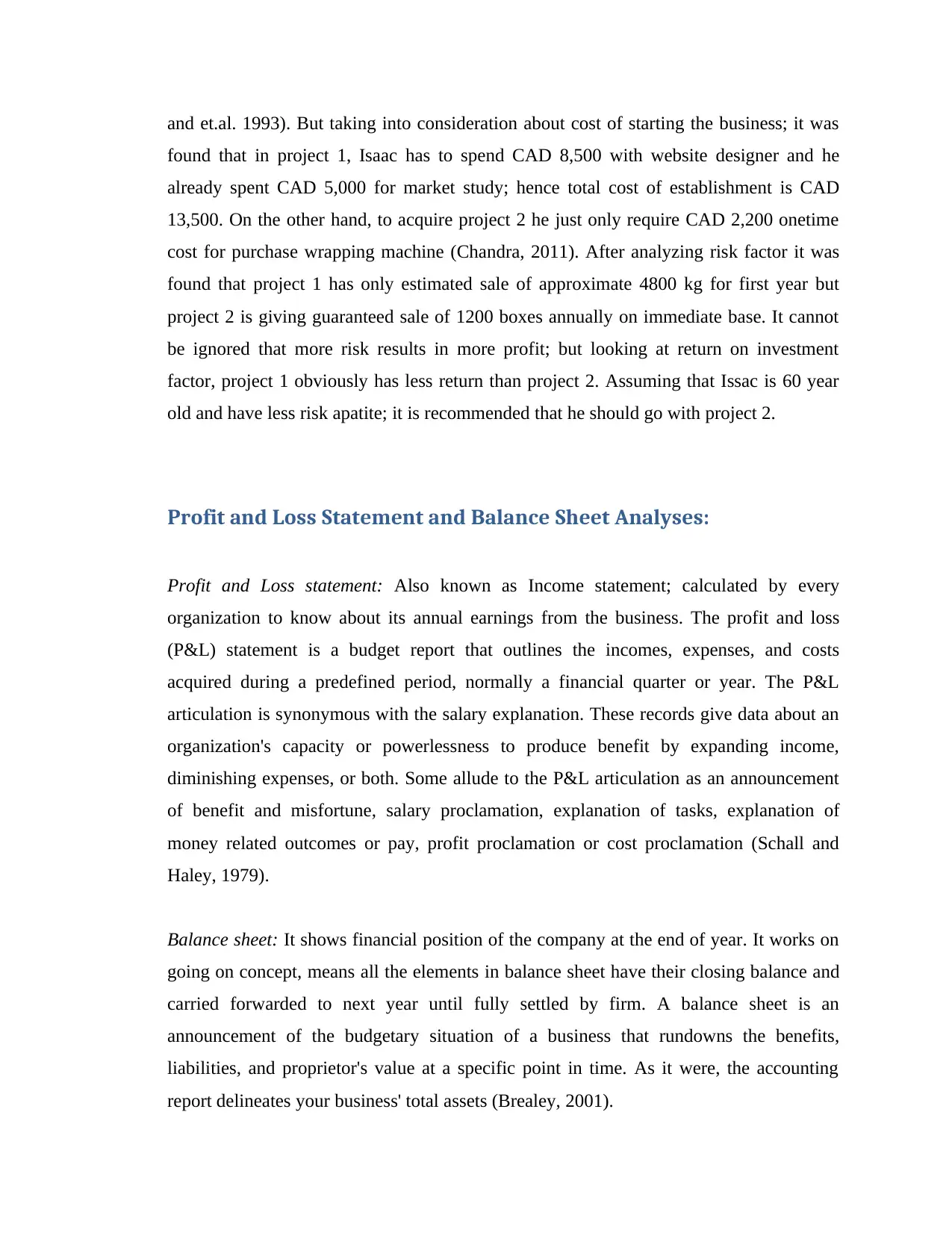
and et.al. 1993). But taking into consideration about cost of starting the business; it was
found that in project 1, Isaac has to spend CAD 8,500 with website designer and he
already spent CAD 5,000 for market study; hence total cost of establishment is CAD
13,500. On the other hand, to acquire project 2 he just only require CAD 2,200 onetime
cost for purchase wrapping machine (Chandra, 2011). After analyzing risk factor it was
found that project 1 has only estimated sale of approximate 4800 kg for first year but
project 2 is giving guaranteed sale of 1200 boxes annually on immediate base. It cannot
be ignored that more risk results in more profit; but looking at return on investment
factor, project 1 obviously has less return than project 2. Assuming that Issac is 60 year
old and have less risk apatite; it is recommended that he should go with project 2.
Profit and Loss Statement and Balance Sheet Analyses:
Profit and Loss statement: Also known as Income statement; calculated by every
organization to know about its annual earnings from the business. The profit and loss
(P&L) statement is a budget report that outlines the incomes, expenses, and costs
acquired during a predefined period, normally a financial quarter or year. The P&L
articulation is synonymous with the salary explanation. These records give data about an
organization's capacity or powerlessness to produce benefit by expanding income,
diminishing expenses, or both. Some allude to the P&L articulation as an announcement
of benefit and misfortune, salary proclamation, explanation of tasks, explanation of
money related outcomes or pay, profit proclamation or cost proclamation (Schall and
Haley, 1979).
Balance sheet: It shows financial position of the company at the end of year. It works on
going on concept, means all the elements in balance sheet have their closing balance and
carried forwarded to next year until fully settled by firm. A balance sheet is an
announcement of the budgetary situation of a business that rundowns the benefits,
liabilities, and proprietor's value at a specific point in time. As it were, the accounting
report delineates your business' total assets (Brealey, 2001).
found that in project 1, Isaac has to spend CAD 8,500 with website designer and he
already spent CAD 5,000 for market study; hence total cost of establishment is CAD
13,500. On the other hand, to acquire project 2 he just only require CAD 2,200 onetime
cost for purchase wrapping machine (Chandra, 2011). After analyzing risk factor it was
found that project 1 has only estimated sale of approximate 4800 kg for first year but
project 2 is giving guaranteed sale of 1200 boxes annually on immediate base. It cannot
be ignored that more risk results in more profit; but looking at return on investment
factor, project 1 obviously has less return than project 2. Assuming that Issac is 60 year
old and have less risk apatite; it is recommended that he should go with project 2.
Profit and Loss Statement and Balance Sheet Analyses:
Profit and Loss statement: Also known as Income statement; calculated by every
organization to know about its annual earnings from the business. The profit and loss
(P&L) statement is a budget report that outlines the incomes, expenses, and costs
acquired during a predefined period, normally a financial quarter or year. The P&L
articulation is synonymous with the salary explanation. These records give data about an
organization's capacity or powerlessness to produce benefit by expanding income,
diminishing expenses, or both. Some allude to the P&L articulation as an announcement
of benefit and misfortune, salary proclamation, explanation of tasks, explanation of
money related outcomes or pay, profit proclamation or cost proclamation (Schall and
Haley, 1979).
Balance sheet: It shows financial position of the company at the end of year. It works on
going on concept, means all the elements in balance sheet have their closing balance and
carried forwarded to next year until fully settled by firm. A balance sheet is an
announcement of the budgetary situation of a business that rundowns the benefits,
liabilities, and proprietor's value at a specific point in time. As it were, the accounting
report delineates your business' total assets (Brealey, 2001).
Paraphrase This Document
Need a fresh take? Get an instant paraphrase of this document with our AI Paraphraser
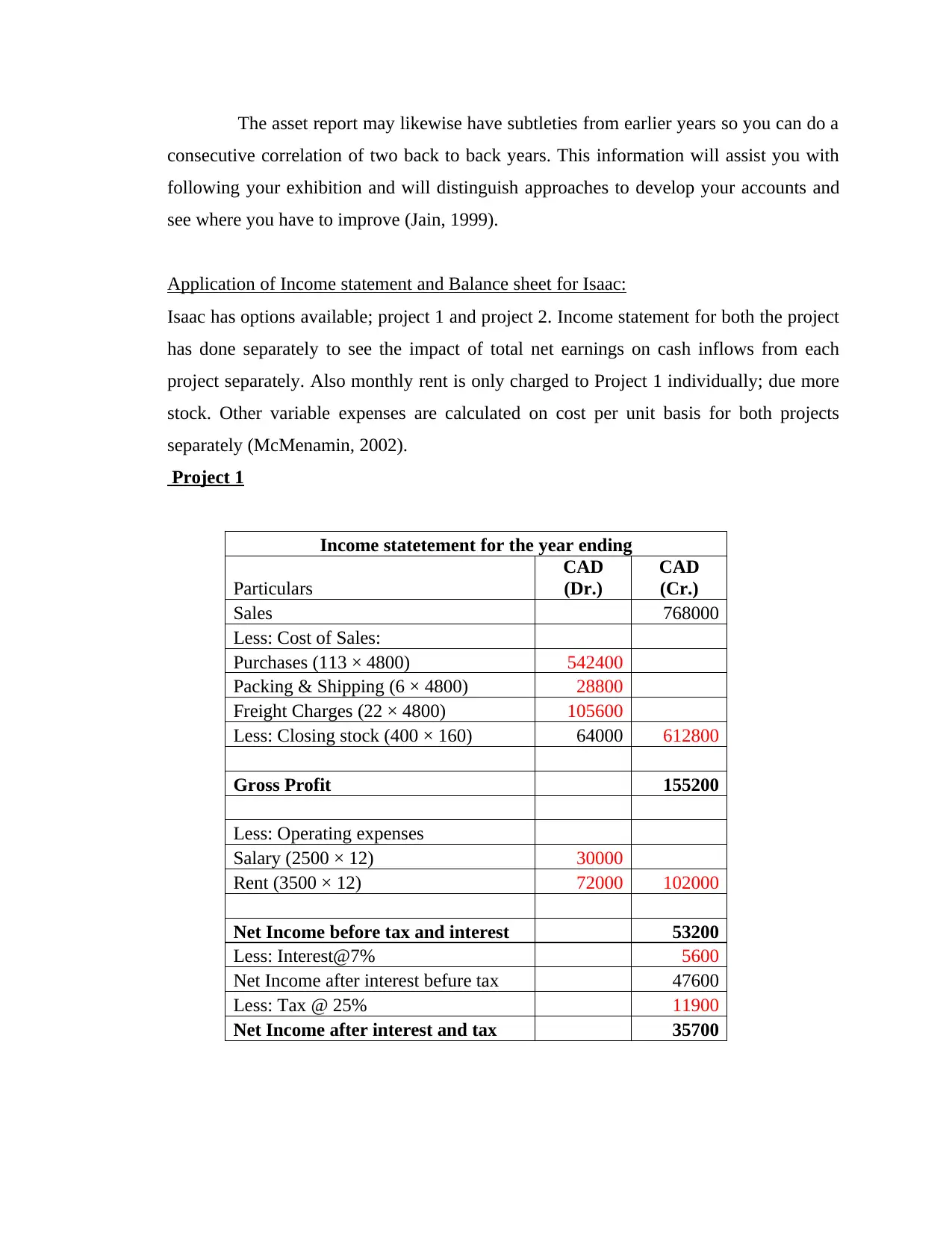
The asset report may likewise have subtleties from earlier years so you can do a
consecutive correlation of two back to back years. This information will assist you with
following your exhibition and will distinguish approaches to develop your accounts and
see where you have to improve (Jain, 1999).
Application of Income statement and Balance sheet for Isaac:
Isaac has options available; project 1 and project 2. Income statement for both the project
has done separately to see the impact of total net earnings on cash inflows from each
project separately. Also monthly rent is only charged to Project 1 individually; due more
stock. Other variable expenses are calculated on cost per unit basis for both projects
separately (McMenamin, 2002).
Project 1
Income statetement for the year ending
Particulars
CAD
(Dr.)
CAD
(Cr.)
Sales 768000
Less: Cost of Sales:
Purchases (113 × 4800) 542400
Packing & Shipping (6 × 4800) 28800
Freight Charges (22 × 4800) 105600
Less: Closing stock (400 × 160) 64000 612800
Gross Profit 155200
Less: Operating expenses
Salary (2500 × 12) 30000
Rent (3500 × 12) 72000 102000
Net Income before tax and interest 53200
Less: Interest@7% 5600
Net Income after interest befure tax 47600
Less: Tax @ 25% 11900
Net Income after interest and tax 35700
consecutive correlation of two back to back years. This information will assist you with
following your exhibition and will distinguish approaches to develop your accounts and
see where you have to improve (Jain, 1999).
Application of Income statement and Balance sheet for Isaac:
Isaac has options available; project 1 and project 2. Income statement for both the project
has done separately to see the impact of total net earnings on cash inflows from each
project separately. Also monthly rent is only charged to Project 1 individually; due more
stock. Other variable expenses are calculated on cost per unit basis for both projects
separately (McMenamin, 2002).
Project 1
Income statetement for the year ending
Particulars
CAD
(Dr.)
CAD
(Cr.)
Sales 768000
Less: Cost of Sales:
Purchases (113 × 4800) 542400
Packing & Shipping (6 × 4800) 28800
Freight Charges (22 × 4800) 105600
Less: Closing stock (400 × 160) 64000 612800
Gross Profit 155200
Less: Operating expenses
Salary (2500 × 12) 30000
Rent (3500 × 12) 72000 102000
Net Income before tax and interest 53200
Less: Interest@7% 5600
Net Income after interest befure tax 47600
Less: Tax @ 25% 11900
Net Income after interest and tax 35700

Working Note:
Freight charges per kg is given as €14/kg;
taking exchange value 1 CAD = 0.64 Euro
€14 × 1.52 = CAD 22 approximate
Closing stock is assumed to be 400 per month 400 kg × CAD 160/kg (sale price)
= CAD 64000
Annual interest rate is calculate on CAD 80000
borrowings @ 7%
Interpretation: In project 1 where the sales are done through internet; Isaac will receive
CAD 442500 at the end of year, which gives approximate 57% return on sales. It is huge
future returns but this Income statement has many hidden expenses which requires to be
deducted from net revenue; for instance selling and distribution charges are not there;
labor charges should also be included, cost of handling product at warehouse is missing
and lastly various day to day expenses such as; electricity payment, transportation cost,
petrol, internet recharge, salaries of other staff, monthly expenses to be paid to website
servers, etc. is emitted. Thus it still assumed that Uncle Isaac will get at least 20% return
which is also a good earnings for starting year (Cornett and Saunders, 2003).
Balance sheet:
Balance sheet as on year
Particulars CAD CAD
ASSETS
Fixed Assets:
Refrigerator 15500
Security Amount 10500 26000
Other Assets:
Miscellaneous Assets:
Website Design 8500
Market Analysis 5000 13500
Current Assets:
Prepaid Rent 3500
Prepaid Remitted credit card handling fee 768
Bank (balancing figure)
87193
2
87620
0
Freight charges per kg is given as €14/kg;
taking exchange value 1 CAD = 0.64 Euro
€14 × 1.52 = CAD 22 approximate
Closing stock is assumed to be 400 per month 400 kg × CAD 160/kg (sale price)
= CAD 64000
Annual interest rate is calculate on CAD 80000
borrowings @ 7%
Interpretation: In project 1 where the sales are done through internet; Isaac will receive
CAD 442500 at the end of year, which gives approximate 57% return on sales. It is huge
future returns but this Income statement has many hidden expenses which requires to be
deducted from net revenue; for instance selling and distribution charges are not there;
labor charges should also be included, cost of handling product at warehouse is missing
and lastly various day to day expenses such as; electricity payment, transportation cost,
petrol, internet recharge, salaries of other staff, monthly expenses to be paid to website
servers, etc. is emitted. Thus it still assumed that Uncle Isaac will get at least 20% return
which is also a good earnings for starting year (Cornett and Saunders, 2003).
Balance sheet:
Balance sheet as on year
Particulars CAD CAD
ASSETS
Fixed Assets:
Refrigerator 15500
Security Amount 10500 26000
Other Assets:
Miscellaneous Assets:
Website Design 8500
Market Analysis 5000 13500
Current Assets:
Prepaid Rent 3500
Prepaid Remitted credit card handling fee 768
Bank (balancing figure)
87193
2
87620
0
⊘ This is a preview!⊘
Do you want full access?
Subscribe today to unlock all pages.

Trusted by 1+ million students worldwide
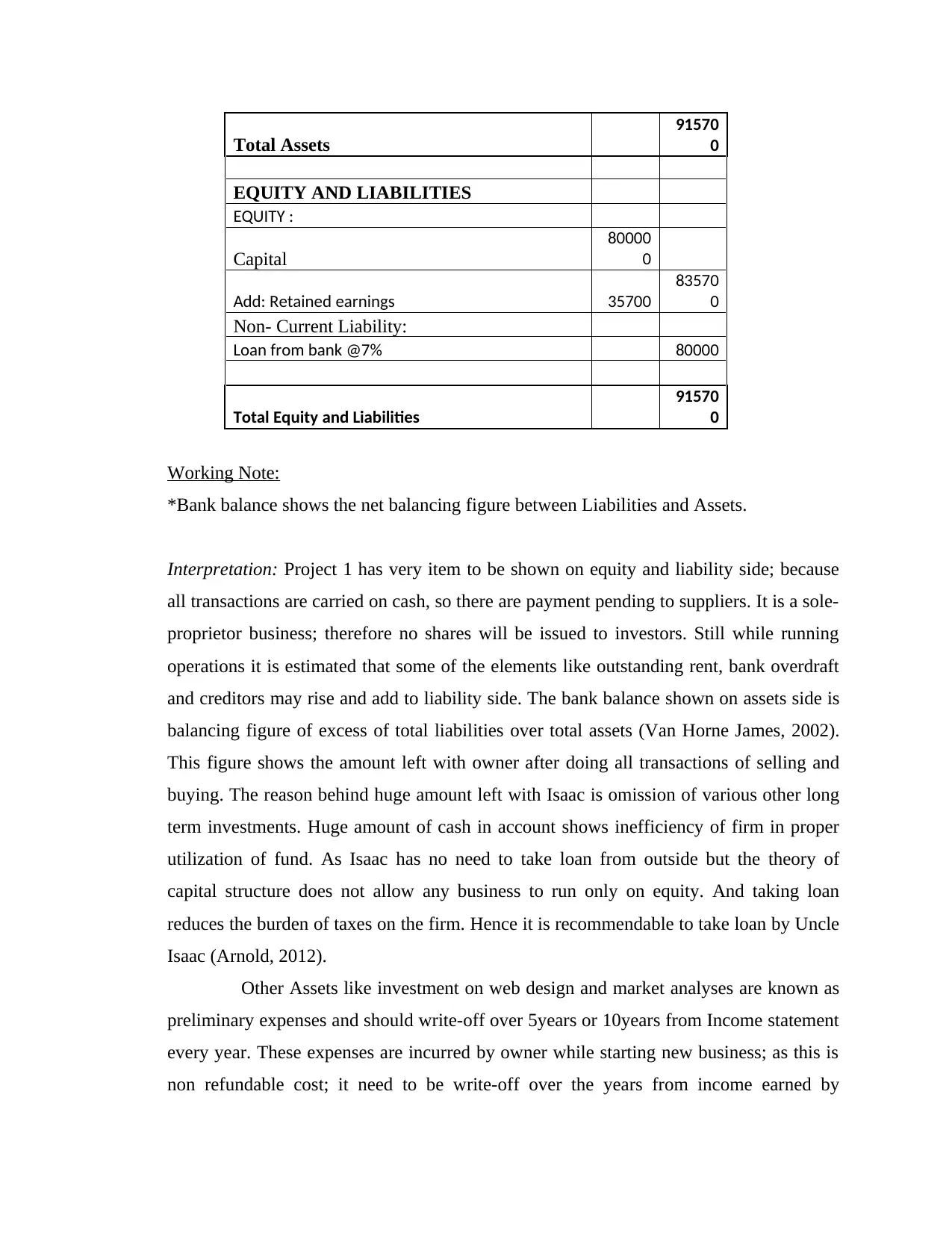
Total Assets
91570
0
EQUITY AND LIABILITIES
EQUITY :
Capital
80000
0
Add: Retained earnings 35700
83570
0
Non- Current Liability:
Loan from bank @7% 80000
Total Equity and Liabilities
91570
0
Working Note:
*Bank balance shows the net balancing figure between Liabilities and Assets.
Interpretation: Project 1 has very item to be shown on equity and liability side; because
all transactions are carried on cash, so there are payment pending to suppliers. It is a sole-
proprietor business; therefore no shares will be issued to investors. Still while running
operations it is estimated that some of the elements like outstanding rent, bank overdraft
and creditors may rise and add to liability side. The bank balance shown on assets side is
balancing figure of excess of total liabilities over total assets (Van Horne James, 2002).
This figure shows the amount left with owner after doing all transactions of selling and
buying. The reason behind huge amount left with Isaac is omission of various other long
term investments. Huge amount of cash in account shows inefficiency of firm in proper
utilization of fund. As Isaac has no need to take loan from outside but the theory of
capital structure does not allow any business to run only on equity. And taking loan
reduces the burden of taxes on the firm. Hence it is recommendable to take loan by Uncle
Isaac (Arnold, 2012).
Other Assets like investment on web design and market analyses are known as
preliminary expenses and should write-off over 5years or 10years from Income statement
every year. These expenses are incurred by owner while starting new business; as this is
non refundable cost; it need to be write-off over the years from income earned by
91570
0
EQUITY AND LIABILITIES
EQUITY :
Capital
80000
0
Add: Retained earnings 35700
83570
0
Non- Current Liability:
Loan from bank @7% 80000
Total Equity and Liabilities
91570
0
Working Note:
*Bank balance shows the net balancing figure between Liabilities and Assets.
Interpretation: Project 1 has very item to be shown on equity and liability side; because
all transactions are carried on cash, so there are payment pending to suppliers. It is a sole-
proprietor business; therefore no shares will be issued to investors. Still while running
operations it is estimated that some of the elements like outstanding rent, bank overdraft
and creditors may rise and add to liability side. The bank balance shown on assets side is
balancing figure of excess of total liabilities over total assets (Van Horne James, 2002).
This figure shows the amount left with owner after doing all transactions of selling and
buying. The reason behind huge amount left with Isaac is omission of various other long
term investments. Huge amount of cash in account shows inefficiency of firm in proper
utilization of fund. As Isaac has no need to take loan from outside but the theory of
capital structure does not allow any business to run only on equity. And taking loan
reduces the burden of taxes on the firm. Hence it is recommendable to take loan by Uncle
Isaac (Arnold, 2012).
Other Assets like investment on web design and market analyses are known as
preliminary expenses and should write-off over 5years or 10years from Income statement
every year. These expenses are incurred by owner while starting new business; as this is
non refundable cost; it need to be write-off over the years from income earned by
Paraphrase This Document
Need a fresh take? Get an instant paraphrase of this document with our AI Paraphraser
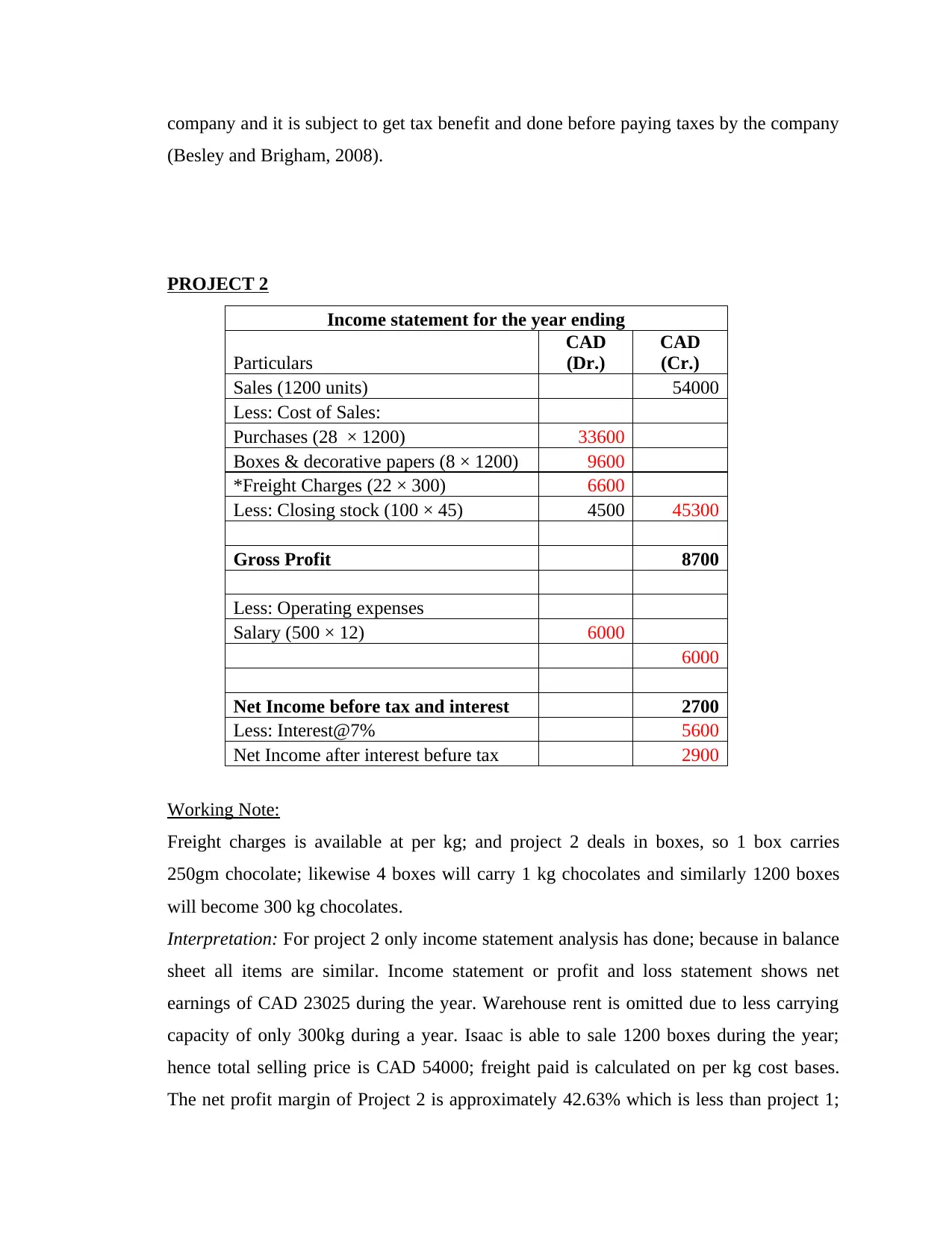
company and it is subject to get tax benefit and done before paying taxes by the company
(Besley and Brigham, 2008).
PROJECT 2
Income statement for the year ending
Particulars
CAD
(Dr.)
CAD
(Cr.)
Sales (1200 units) 54000
Less: Cost of Sales:
Purchases (28 × 1200) 33600
Boxes & decorative papers (8 × 1200) 9600
*Freight Charges (22 × 300) 6600
Less: Closing stock (100 × 45) 4500 45300
Gross Profit 8700
Less: Operating expenses
Salary (500 × 12) 6000
6000
Net Income before tax and interest 2700
Less: Interest@7% 5600
Net Income after interest befure tax 2900
Working Note:
Freight charges is available at per kg; and project 2 deals in boxes, so 1 box carries
250gm chocolate; likewise 4 boxes will carry 1 kg chocolates and similarly 1200 boxes
will become 300 kg chocolates.
Interpretation: For project 2 only income statement analysis has done; because in balance
sheet all items are similar. Income statement or profit and loss statement shows net
earnings of CAD 23025 during the year. Warehouse rent is omitted due to less carrying
capacity of only 300kg during a year. Isaac is able to sale 1200 boxes during the year;
hence total selling price is CAD 54000; freight paid is calculated on per kg cost bases.
The net profit margin of Project 2 is approximately 42.63% which is less than project 1;
(Besley and Brigham, 2008).
PROJECT 2
Income statement for the year ending
Particulars
CAD
(Dr.)
CAD
(Cr.)
Sales (1200 units) 54000
Less: Cost of Sales:
Purchases (28 × 1200) 33600
Boxes & decorative papers (8 × 1200) 9600
*Freight Charges (22 × 300) 6600
Less: Closing stock (100 × 45) 4500 45300
Gross Profit 8700
Less: Operating expenses
Salary (500 × 12) 6000
6000
Net Income before tax and interest 2700
Less: Interest@7% 5600
Net Income after interest befure tax 2900
Working Note:
Freight charges is available at per kg; and project 2 deals in boxes, so 1 box carries
250gm chocolate; likewise 4 boxes will carry 1 kg chocolates and similarly 1200 boxes
will become 300 kg chocolates.
Interpretation: For project 2 only income statement analysis has done; because in balance
sheet all items are similar. Income statement or profit and loss statement shows net
earnings of CAD 23025 during the year. Warehouse rent is omitted due to less carrying
capacity of only 300kg during a year. Isaac is able to sale 1200 boxes during the year;
hence total selling price is CAD 54000; freight paid is calculated on per kg cost bases.
The net profit margin of Project 2 is approximately 42.63% which is less than project 1;

the reason is fewer sales as it only able to supply 300 kg to Jade annually (Fabozzi and
Peterson, 2003).
Monthly cash flow for the first year of operation
Project 1:
This project is receiving uneven cash flows during the year, starting month sale is 50 kg
per month but at the end of the year it will increase to 750 kg per month, so as an average
there will be 400 kg chocolates sale per month. Calculation of monthly rough cash
inflows at 50 kg per month:
Sale 50 × 160 = CAD 8000
Less: total variable cost @ 6 per kg 6 × 160 = CAD 960
Less: Monthly rent 3500 * 3/4 CAD 2625
Less: Monthly salary CAD 2500
Earning for month CAD 1915
The minimum earning from project 1 is CAD 1915 per month, unexpected costs such as
loss due to damage of chocolates and low demand are kept constant. Rent is shared
among two projects according total quantity ordered together. Hence project one’s share
will be 3/4th (Madura, 2020).
Project 2
This project has regular cash flows which is 100 boxes per month for two years. It will
also support Isaac in meeting with irregular cash received from project 1. One box carries
only 250 gm chocolates; which is different standard of unit of sale. If needed it should be
converted into kg for an ease in collaborative income statement. As both the projects are
different, it is suggested that business should calculate cash inflows from each project
separately. This will help Isaac in knowing which project is doing well and which one
not. If not possible to make different Income statement due to tax liability; then company
should adopt a tool which can calculate cash flows on share basis and the purpose of this
calculation should be limited for analyses only (Banerjee, 2012). The monthly cash
inflows of project 2 are done below:
Peterson, 2003).
Monthly cash flow for the first year of operation
Project 1:
This project is receiving uneven cash flows during the year, starting month sale is 50 kg
per month but at the end of the year it will increase to 750 kg per month, so as an average
there will be 400 kg chocolates sale per month. Calculation of monthly rough cash
inflows at 50 kg per month:
Sale 50 × 160 = CAD 8000
Less: total variable cost @ 6 per kg 6 × 160 = CAD 960
Less: Monthly rent 3500 * 3/4 CAD 2625
Less: Monthly salary CAD 2500
Earning for month CAD 1915
The minimum earning from project 1 is CAD 1915 per month, unexpected costs such as
loss due to damage of chocolates and low demand are kept constant. Rent is shared
among two projects according total quantity ordered together. Hence project one’s share
will be 3/4th (Madura, 2020).
Project 2
This project has regular cash flows which is 100 boxes per month for two years. It will
also support Isaac in meeting with irregular cash received from project 1. One box carries
only 250 gm chocolates; which is different standard of unit of sale. If needed it should be
converted into kg for an ease in collaborative income statement. As both the projects are
different, it is suggested that business should calculate cash inflows from each project
separately. This will help Isaac in knowing which project is doing well and which one
not. If not possible to make different Income statement due to tax liability; then company
should adopt a tool which can calculate cash flows on share basis and the purpose of this
calculation should be limited for analyses only (Banerjee, 2012). The monthly cash
inflows of project 2 are done below:
⊘ This is a preview!⊘
Do you want full access?
Subscribe today to unlock all pages.

Trusted by 1+ million students worldwide
1 out of 24
Related Documents
Your All-in-One AI-Powered Toolkit for Academic Success.
+13062052269
info@desklib.com
Available 24*7 on WhatsApp / Email
![[object Object]](/_next/static/media/star-bottom.7253800d.svg)
Unlock your academic potential
Copyright © 2020–2025 A2Z Services. All Rights Reserved. Developed and managed by ZUCOL.





